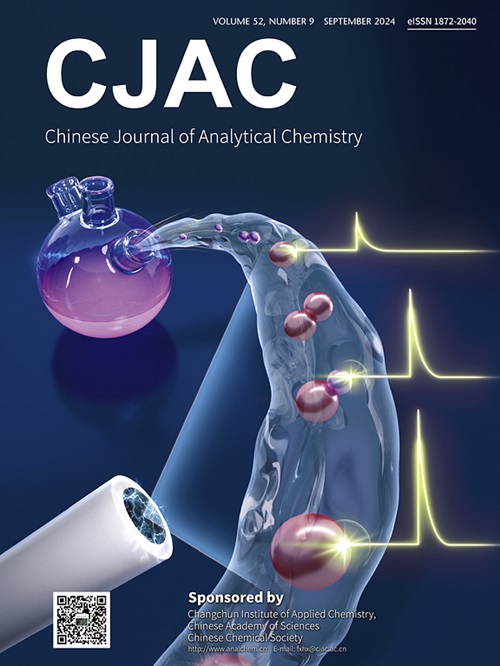采用UPLC-MS/MS同时检测方法对牛膝总皂苷灌胃、腹腔和静脉给药的组织分布进行比较分析
IF 1.3
4区 化学
Q4 CHEMISTRY, ANALYTICAL
引用次数: 0
摘要
牛膝草皂苷是牛膝草的主要生物活性成分,具有神经保护和抗炎作用。然而,缺乏药代动力学(PK)数据,特别是组织分布和首过效应,严重阻碍了它们的治疗发展。因此,验证了一种快速超高效液相色谱-串联质谱(UPLC-MS/MS)方法(运行时间9 min),可同时定量小鼠组织(脑、心、肝、脾、肺、肾;N = 5(每个时间点),分别在给药后10、30、60、120、240分钟。该方法具有良好的线性(R2 >;0.99, 1 ~ 2500 ng/mL),精密度(RSD≤7.04 %),准确度(85% ~ 115 %),回收率(86.6% ~ 97.2% %,RSD≤11.39 %)均符合ICH M10指南。结果表明,IG和IP给药后各组织中皂苷浓度均低于静脉给药,仅为静脉给药后的10 %。虽然这些化合物都是具有齐墩烷骨架的五环三萜皂苷,但它们在体内的组织分布差异很大。牛膝花苷D、人参皂苷R0和二甲苷A在各组织中的消除相对缓慢。相比之下,千叶皂苷IVa从各种组织中迅速消除。四种皂苷的血脑屏障穿越能力对中枢神经系统疾病治疗药物的开发非常有益。此外,不同给药途径的结果表明,AB皂苷在体内可能表现出明显的胃肠道和肝脏首过效应,这在未来的研究中值得考虑。本研究可指导AB皂苷的多途径研究,为优化处方和设计给药方案以减轻首过效应提供重要见解本文章由计算机程序翻译,如有差异,请以英文原文为准。

Comparative tissue distribution analysis of Achyranthes bidentata Blume saponins via intragastric, intraperitoneal, and intravenous administration using simultaneous UPLC-MS/MS detection
Saponins, the primary bioactive components of Achyranthes bidentata Blume (AB), exhibit neuroprotective and anti-inflammatory properties. However, the lack of pharmacokinetic (PK) data, particularly on tissue distribution and first-pass effects, critically hinders their therapeutic development. Therefore, a rapid ultra-performance liquid chromatography–tandem mass spectrometry (UPLC-MS/MS) method (9-min run time) was validated to simultaneously quantify five AB saponins in mice tissues (brain, heart, liver, spleen, lung, kidney; n = 5 per time point) at 10, 30, 60, 120, 240 min post-administration. The method demonstrated excellent linearity (R2 > 0.99, 1–2500 ng/mL), precision (RSD ≤ 7.04 %), accuracy (85%–115 %), and recovery rates (86.6%–97.2 %, RSD ≤ 11.39 %) per ICH M10 guidelines. The results demonstrate that the saponin concentrations in various tissues after IG and IP administration were lower compared to those after IV administration, with levels reaching only 10 % of the latter. Although all these compounds are pentacyclic triterpenoid saponins with an oleanane skeleton, their tissue distribution in vivo varies significantly. The elimination of achyranthoside D, ginsenoside R0, and araloside A is relatively slow in various tissues. In contrast, chikusetsusaponin IVa is rapidly eliminated from various tissues. The ability of four saponins to cross the blood-brain barrier is highly beneficial for the development of therapeutic drugs for central nervous system diseases. Additionally, the results from different administration routes indicate that AB saponins may exhibit a pronounced gastrointestinal and hepatic first-pass effect in vivo, which should be considered in future research. This study can guide multi-route study of AB saponins provides critical insights for formulation optimization and dosing regimen design to mitigate first-pass effects
求助全文
通过发布文献求助,成功后即可免费获取论文全文。
去求助
来源期刊
CiteScore
3.60
自引率
25.00%
发文量
17223
审稿时长
35 days
期刊介绍:
Chinese Journal of Analytical Chemistry(CJAC) is an academic journal of analytical chemistry established in 1972 and sponsored by the Chinese Chemical Society and Changchun Institute of Applied Chemistry, Chinese Academy of Sciences. Its objectives are to report the original scientific research achievements and review the recent development of analytical chemistry in all areas. The journal sets up 5 columns including Research Papers, Research Notes, Experimental Technique and Instrument, Review and Progress and Summary Accounts. The journal published monthly in Chinese language. A detailed abstract, keywords and the titles of figures and tables are provided in English, except column of Summary Accounts. Prof. Wang Erkang, an outstanding analytical chemist, academician of Chinese Academy of Sciences & Third World Academy of Sciences, holds the post of the Editor-in-chief.

 求助内容:
求助内容: 应助结果提醒方式:
应助结果提醒方式:


